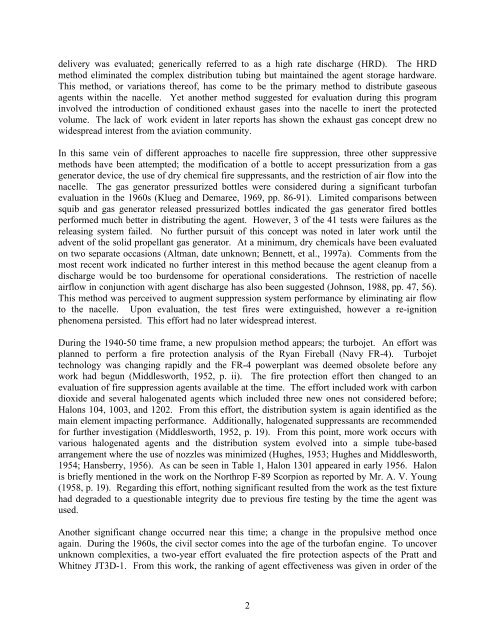FAA Engine Compartment Halon Replacement Project Background ...
FAA Engine Compartment Halon Replacement Project Background ...
FAA Engine Compartment Halon Replacement Project Background ...
Create successful ePaper yourself
Turn your PDF publications into a flip-book with our unique Google optimized e-Paper software.
delivery was evaluated; generically referred to as a high rate discharge (HRD). The HRD<br />
method eliminated the complex distribution tubing but maintained the agent storage hardware.<br />
This method, or variations thereof, has come to be the primary method to distribute gaseous<br />
agents within the nacelle. Yet another method suggested for evaluation during this program<br />
involved the introduction of conditioned exhaust gases into the nacelle to inert the protected<br />
volume. The lack of work evident in later reports has shown the exhaust gas concept drew no<br />
widespread interest from the aviation community.<br />
In this same vein of different approaches to nacelle fire suppression, three other suppressive<br />
methods have been attempted; the modification of a bottle to accept pressurization from a gas<br />
generator device, the use of dry chemical fire suppressants, and the restriction of air flow into the<br />
nacelle. The gas generator pressurized bottles were considered during a significant turbofan<br />
evaluation in the 1960s (Klueg and Demaree, 1969, pp. 86-91). Limited comparisons between<br />
squib and gas generator released pressurized bottles indicated the gas generator fired bottles<br />
performed much better in distributing the agent. However, 3 of the 41 tests were failures as the<br />
releasing system failed. No further pursuit of this concept was noted in later work until the<br />
advent of the solid propellant gas generator. At a minimum, dry chemicals have been evaluated<br />
on two separate occasions (Altman, date unknown; Bennett, et al., 1997a). Comments from the<br />
most recent work indicated no further interest in this method because the agent cleanup from a<br />
discharge would be too burdensome for operational considerations. The restriction of nacelle<br />
airflow in conjunction with agent discharge has also been suggested (Johnson, 1988, pp. 47, 56).<br />
This method was perceived to augment suppression system performance by eliminating air flow<br />
to the nacelle. Upon evaluation, the test fires were extinguished, however a re-ignition<br />
phenomena persisted. This effort had no later widespread interest.<br />
During the 1940-50 time frame, a new propulsion method appears; the turbojet. An effort was<br />
planned to perform a fire protection analysis of the Ryan Fireball (Navy FR-4). Turbojet<br />
technology was changing rapidly and the FR-4 powerplant was deemed obsolete before any<br />
work had begun (Middlesworth, 1952, p. ii). The fire protection effort then changed to an<br />
evaluation of fire suppression agents available at the time. The effort included work with carbon<br />
dioxide and several halogenated agents which included three new ones not considered before;<br />
<strong>Halon</strong>s 104, 1003, and 1202. From this effort, the distribution system is again identified as the<br />
main element impacting performance. Additionally, halogenated suppressants are recommended<br />
for further investigation (Middlesworth, 1952, p. 19). From this point, more work occurs with<br />
various halogenated agents and the distribution system evolved into a simple tube-based<br />
arrangement where the use of nozzles was minimized (Hughes, 1953; Hughes and Middlesworth,<br />
1954; Hansberry, 1956). As can be seen in Table 1, <strong>Halon</strong> 1301 appeared in early 1956. <strong>Halon</strong><br />
is briefly mentioned in the work on the Northrop F-89 Scorpion as reported by Mr. A. V. Young<br />
(1958, p. 19). Regarding this effort, nothing significant resulted from the work as the test fixture<br />
had degraded to a questionable integrity due to previous fire testing by the time the agent was<br />
used.<br />
Another significant change occurred near this time; a change in the propulsive method once<br />
again. During the 1960s, the civil sector comes into the age of the turbofan engine. To uncover<br />
unknown complexities, a two-year effort evaluated the fire protection aspects of the Pratt and<br />
Whitney JT3D-1. From this work, the ranking of agent effectiveness was given in order of the<br />
2
















